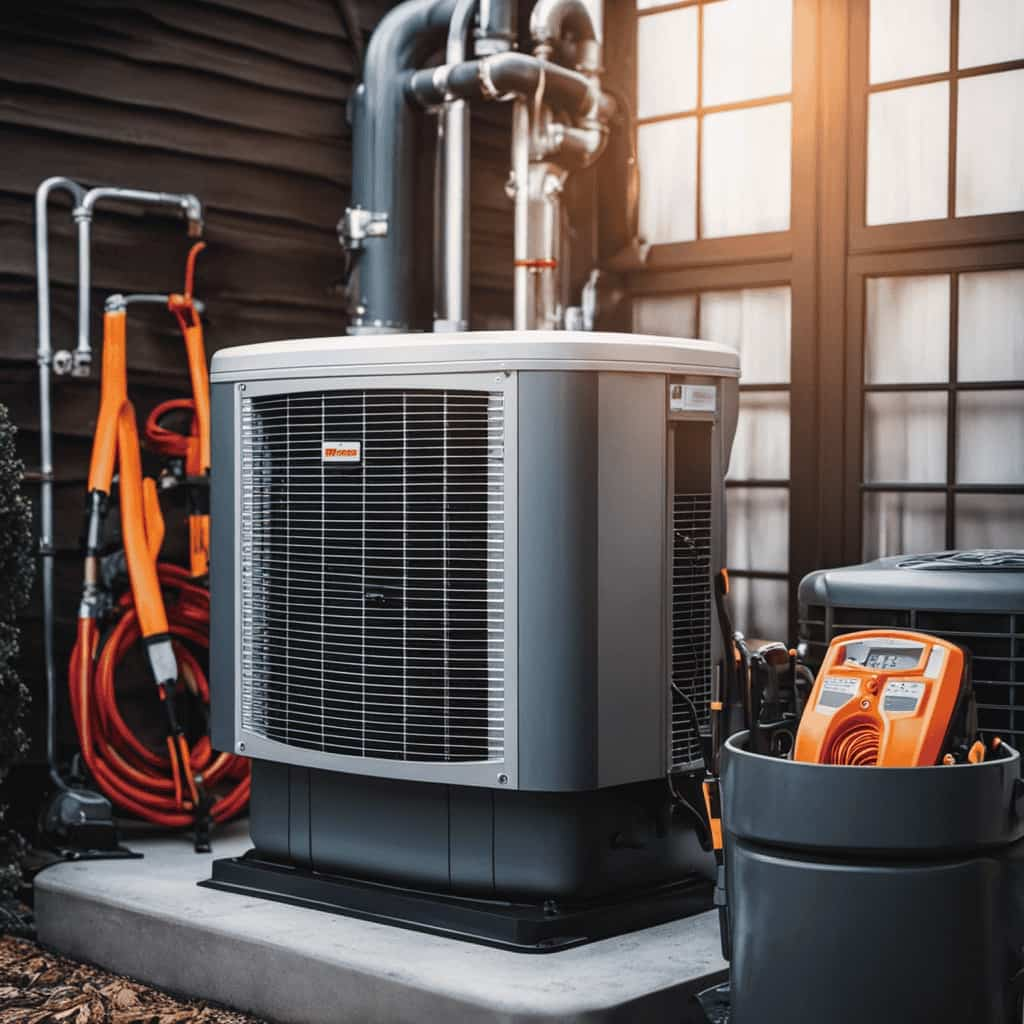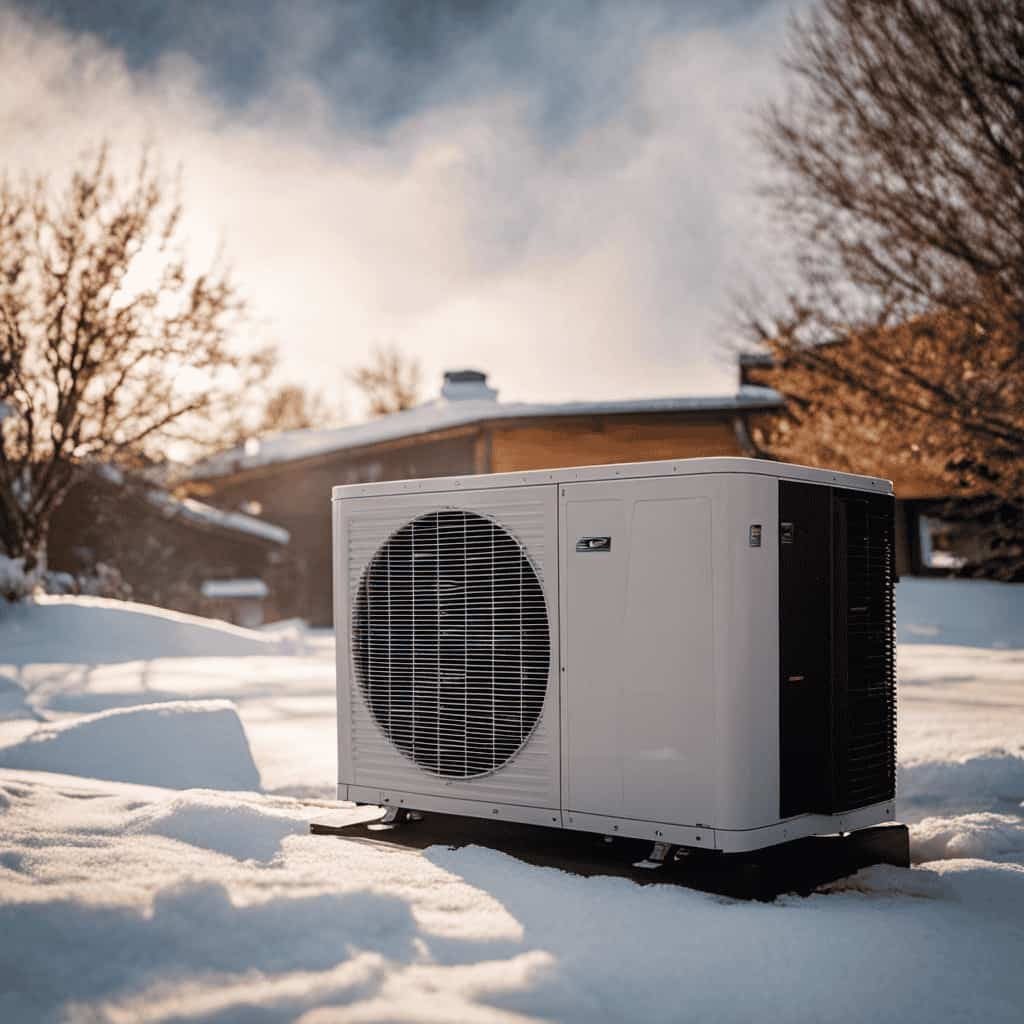Welcome to our guide on eco-friendly heating, where we will delve into the effects and effectiveness of sustainable heating systems.
Just like a compass guiding us towards a brighter future, this article will delve into the environmental effects of different heating technologies.
We will analyze the efficiency of green heating options, such as heat pumps and biomass systems, and uncover the role of solar thermal solutions.
Join us as we navigate the path towards a greener, more liberating way of heating our homes.

Key Takeaways
- Green heating systems, such as solar and geothermal systems, offer sustainable alternatives to traditional heating systems using fossil fuels.
- Efficient insulation, heat recovery ventilation systems, and smart thermostats can improve energy efficiency and reduce energy consumption in green heating systems.
- Heat pumps are a versatile and energy-efficient option for sustainable heating, extracting heat from renewable sources and contributing to energy savings.
- Biomass heating, utilizing renewable organic materials, can be cost-effective compared to fossil fuel systems and has advanced emission control systems to mitigate environmental impact.
Understanding the Environmental Impact of Heating Systems
How do heating systems impact the environment?
Heating systems play a significant role in our daily lives, but they also have a notable impact on the environment. One of the key considerations is the carbon footprint associated with heating systems. Traditional systems that rely on fossil fuels, such as oil or natural gas, emit greenhouse gases that contribute to climate change.
This has led to an increased interest in renewable energy sources for heating, such as solar or geothermal systems. By utilizing these sustainable alternatives, we can minimize our carbon footprint and reduce our impact on the environment.
Renewable energy heating systems not only provide a more eco-friendly option, but they also offer long-term cost savings and energy efficiency. It’s crucial for individuals and businesses to understand the environmental impact of heating systems and make informed decisions to promote a greener future.

Exploring the Efficiency of Green Heating Technologies
By analyzing the performance and effectiveness of various green heating technologies, we can determine their efficiency in reducing energy consumption and minimizing environmental impact. When it comes to green heating, two key components play a significant role in maximizing efficiency: geothermal energy and efficient insulation. Here are four important factors to consider:
Geothermal Energy: Utilizing the Earth’s natural heat, geothermal heating systems can provide efficient and consistent heating throughout the year. By tapping into the stable temperatures underground, these systems can significantly reduce energy consumption and greenhouse gas emissions.
Efficient Insulation: Proper insulation is crucial in preventing heat loss and maintaining a comfortable indoor temperature. By investing in high-quality insulation materials and sealing any air leaks, you can minimize energy waste and optimize the performance of your green heating system.
Heat Recovery Ventilation (HRV): HRV systems extract heat from the outgoing air and use it to preheat incoming fresh air. This process reduces the demand for additional heating and improves overall energy efficiency.

Smart Thermostats: Smart thermostats allow for precise temperature control and can automatically adjust settings based on occupancy and weather conditions. This intelligent technology ensures that energy is used efficiently and minimizes unnecessary heating.
The Benefits of Heat Pumps for Sustainable Heating
Heat pumps offer numerous benefits for sustainable heating, making them a valuable addition to any green heating system. These systems work by extracting heat from renewable energy sources such as the ground, air, or water, and transferring it to the interior of a building.
One of the key advantages of heat pumps is their high energy efficiency. They can produce up to three times more heat energy than the electrical energy they consume, resulting in significant energy savings.
Additionally, heat pump installation is relatively straightforward, and they can be integrated into both new and existing buildings. This flexibility makes them a versatile option for sustainable heating.

As we delve deeper into evaluating the energy efficiency of biomass heating, it’s important to consider the advantages that heat pumps bring to the table.
Evaluating the Energy Efficiency of Biomass Heating
So, what exactly makes biomass heating energy efficient?
Biomass heating systems are considered energy efficient due to several factors:
Renewable fuel source: Biomass heating utilizes organic materials such as wood pellets, logs, and agricultural waste, which are renewable resources. Unlike fossil fuels, biomass can be sustainably sourced, reducing the environmental impact.

High energy conversion: Biomass boilers and stoves have high energy conversion rates, meaning they can efficiently convert biomass fuel into heat. This ensures minimal energy wastage and maximizes the utilization of the fuel.
Assessing emissions: Biomass heating systems produce carbon dioxide (CO2) emissions, but these are offset by the carbon absorbed during the growth of the biomass feedstock. Additionally, modern biomass heating technologies have advanced emission control systems that minimize pollutants like particulate matter and nitrogen oxide.
Comparing costs: Biomass heating can be cost-effective compared to fossil fuel-based heating systems. The availability of biomass fuel and potential government incentives can further reduce the overall cost of installation and operation.
The Role of Solar Thermal Systems in Green Heating Solutions
When it comes to green heating solutions, solar thermal systems play a crucial role in harnessing the power of the sun to efficiently heat homes and reduce carbon emissions. Solar thermal innovations have made significant strides in recent years, making these systems more efficient and cost-effective than ever before.

One key advantage of solar thermal systems is their ability to directly convert sunlight into heat energy. These systems typically consist of solar collectors, which absorb sunlight and transfer the heat to a fluid, such as water or antifreeze. This heated fluid can then be used for space heating, water heating, or even to power absorption chillers for cooling purposes.
A cost effectiveness analysis of solar thermal systems reveals their long-term financial benefits. While the initial installation costs can be higher compared to traditional heating systems, the savings in energy bills over time can offset this investment. Additionally, solar thermal systems are eligible for various incentives and rebates, further increasing their cost effectiveness.
Frequently Asked Questions
What Are Some Examples of Heating Systems That Have a High Environmental Impact?
High environmental impact heating systems can include oil furnaces, coal-fired boilers, and electric resistance heaters. However, there are alternative heating options such as geothermal heat pumps and solar heating systems that have a lower environmental impact.
How Do Green Heating Technologies Compare to Traditional Heating Systems in Terms of Efficiency?
How do green heating technologies compare to traditional heating systems in terms of efficiency? We conducted an analysis of the environmental impact and efficiency of different heating systems, specifically looking at the efficiency of green heating technologies versus traditional ones.

Are There Any Drawbacks or Limitations to Using Heat Pumps for Sustainable Heating?
There are some drawbacks and limitations to using heat pumps for sustainable heating. These include the initial cost of installation, the need for electricity, and the dependence on specific temperature ranges for optimal efficiency. Nonetheless, the overall impact and efficiency of heat pumps make them a viable option for green heating.
How Does the Energy Efficiency of Biomass Heating Compare to Other Green Heating Technologies?
When comparing biomass heating efficiency to other green heating technologies, it is important to consider the pros and cons of geothermal heating. This analysis allows us to make informed decisions about energy efficiency.
Can Solar Thermal Systems Be Used in Conjunction With Other Green Heating Solutions to Maximize Efficiency?
Yes, solar thermal systems can be used in conjunction with other green heating solutions to maximize efficiency. The integration of solar thermal technology into hybrid heating systems offers numerous benefits, including increased energy savings and reduced carbon emissions.
What Are the Heat Pump Ratings and How Do They Affect Energy Efficiency?
When considering a heat pump system, understanding its ratings is crucial to evaluate its energy efficiency. The heat pump energy efficiency guide provides valuable information about these ratings. It helps homeowners compare different units and make informed decisions based on factors such as seasonal energy efficiency ratio (SEER) and heating seasonal performance factor (HSPF). By following this guide, individuals can optimize their energy usage and reduce costs while maintaining a comfortable environment.
Conclusion
In conclusion, understanding the environmental impact and efficiency of green heating technologies is crucial for a sustainable future.

Heat pumps offer numerous benefits for sustainable heating, while biomass heating provides an effective energy-efficient solution.
Additionally, solar thermal systems play a significant role in green heating solutions.
By embracing these technologies, we can reduce our carbon footprint and contribute to a cleaner and greener planet.
Let’s prioritize green heating for a more sustainable tomorrow.










